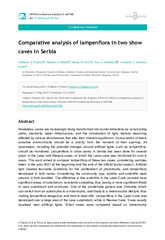Приказ основних података о документу
Comparative analysis of lampenflora in two show caves in Serbia
| dc.creator | Popović, Slađana | |
| dc.creator | Nikolić, Nataša | |
| dc.creator | Pećić, Marija | |
| dc.creator | Anđelković, Ana | |
| dc.creator | Subakov SImić, Gordana | |
| dc.date.accessioned | 2023-09-24T17:25:29Z | |
| dc.date.available | 2023-09-24T17:25:29Z | |
| dc.date.issued | 2022 | |
| dc.identifier.issn | 2603-3925 | |
| dc.identifier.uri | https://plantarum.izbis.bg.ac.rs/handle/123456789/972 | |
| dc.description.abstract | Nowadays, caves are increasingly being transformed into tourist attractions by constructing paths, electricity, water infrastructure, and the introduction of light, thereby becoming affected by various disturbances that alter their inherent equilibrium. Conservation of these sensitive environments should be a priority from the moment of their opening. All parameters, including the potential changes around artificial lights, such as lampenflora, should be monitored. Lampenflora in show caves in Serbia has been done for several years in the Lazar and Resava caves, of which the Lazar cave was monitored for over 6 years. This work aimed to compare lampenflora of these two caves, considering samples taken in the year 2021 at the beginning and the end of the official tourist season. Artificial light created favorable conditions for the proliferation of phototrophs, and lampenflora developed in both caves. Considering the community type, epiliths and endoliths were present in both localities. The difference is that endoliths in the Lazar Cave covered more significant areas of substratum, constantly spreading, thus posing a more significant threat to cave substratum and structures. One of the problematic genera was Chlorella, which can switch from an autotrophic to a mixotrophic, and finally to a heterotrophic lifestyle, thus making lampenflora dangerous and hard to deal with. Lampenflora in the Lazar Cave was developed over a large area of the cave substratum, while in Resava Cave, it was usually localized near artificial lights. When caves were compared based on phototrophic microorganism composition, using multivariate analysis, all morphological groups of Cyanobacteria (coccoid, simple trichal, and heterocystous) were more related to the Resava cave and Chlorophyta and Bacillariophyta to the Lazar Cave (based on diversity and number of sampling sites on which they are found). In the Lazar and Resava cave, Cyanobacteria dominated at the beginning of the tourist season and Chlorophyta at the end. Mosses were present, too, with the difference that the moss protonema was more characteristic of Lazar Cave in many places. In contrast, developed mosses were frequently found in Resava Cave near reflectors. In addition to the analysis of phototrophic microorganisms, ecological parameters, primary production, and biofilm parameters were measured, showing seasonal or sampling site variations. We hope that monitoring will be performed more regularly in the future and that it will include a more significant number of show caves for their conservation. | sr |
| dc.language.iso | en | sr |
| dc.relation | info:eu-repo/grantAgreement/MESTD/inst-2020/200178/RS// | sr |
| dc.relation | info:eu-repo/grantAgreement/MESTD/inst-2020/200010/RS// | sr |
| dc.rights | openAccess | sr |
| dc.rights.uri | https://creativecommons.org/licenses/by/4.0/ | |
| dc.source | ARPHA Conference Abstracts | sr |
| dc.subject | Cyanobacteria and algae | sr |
| dc.subject | lampenflora | sr |
| dc.subject | monitoring | sr |
| dc.subject | show cave | sr |
| dc.subject | ecological threat | sr |
| dc.subject | conservation | sr |
| dc.title | Comparative analysis of lampenflora in two show caves in Serbia | sr |
| dc.type | article | sr |
| dc.rights.license | BY | sr |
| dc.type.version | publishedVersion | sr |
| dc.identifier.doi | 10.3897/aca.5.e87188 | |
| dc.identifier.fulltext | http://plantarum.izbis.bg.ac.rs/bitstream/id/3313/bitstream_3313.pdf |


